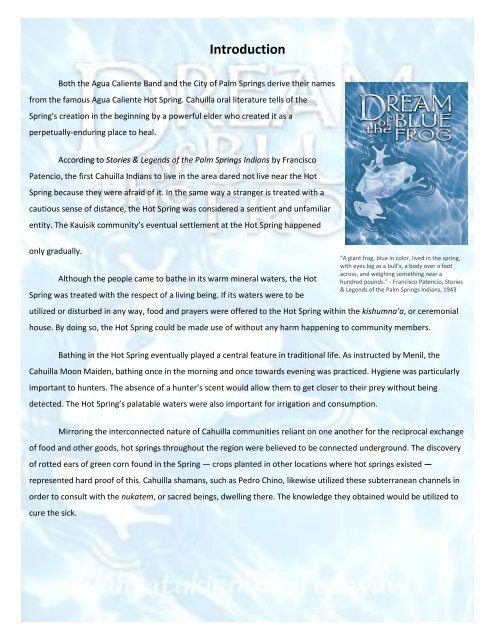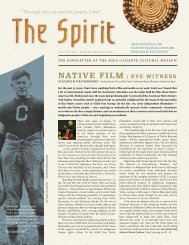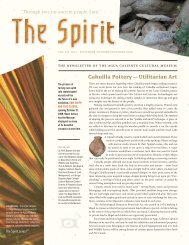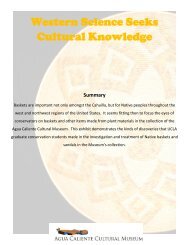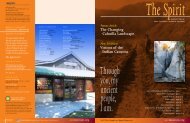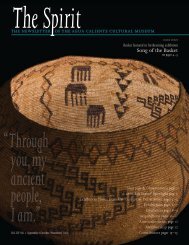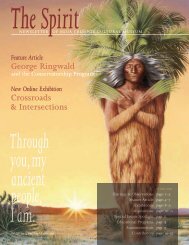You also want an ePaper? Increase the reach of your titles
YUMPU automatically turns print PDFs into web optimized ePapers that Google loves.
Introduction<br />
Both the <strong>Agua</strong> <strong>Caliente</strong> Band and the City of Palm <strong>Spring</strong>s derive their names<br />
from the famous <strong>Agua</strong> <strong>Caliente</strong> <strong>Hot</strong> <strong>Spring</strong>. Cahuilla oral literature tells of the<br />
<strong>Spring</strong>'s creation in the beginning by a powerful elder who created it as a<br />
perpetually-enduring place to heal.<br />
According to Stories & Legends of the Palm <strong>Spring</strong>s Indians by Francisco<br />
Patencio, the first Cahuilla Indians to live in the area dared not live near the <strong>Hot</strong><br />
<strong>Spring</strong> because they were afraid of it. In the same way a stranger is treated with a<br />
cautious sense of distance, the <strong>Hot</strong> <strong>Spring</strong> was considered a sentient and unfamiliar<br />
entity. The Kauisik community’s eventual settlement at the <strong>Hot</strong> <strong>Spring</strong> happened<br />
only gradually.<br />
Although the people came to bathe in its warm mineral waters, the <strong>Hot</strong><br />
<strong>Spring</strong> was treated with the respect of a living being. If its waters were to be<br />
“A giant frog, blue in color, lived in the spring,<br />
with eyes big as a bull’s, a body over a foot<br />
across, and weighing something near a<br />
hundred pounds.” - Francisco Patencio, Stories<br />
& Legends of the Palm <strong>Spring</strong>s Indians, 1943<br />
utilized or disturbed in any way, food and prayers were offered to the <strong>Hot</strong> <strong>Spring</strong> within the kishumna’a, or ceremonial<br />
house. By doing so, the <strong>Hot</strong> <strong>Spring</strong> could be made use of without any harm happening to community members.<br />
Bathing in the <strong>Hot</strong> <strong>Spring</strong> eventually played a central feature in traditional life. As instructed by Menil, the<br />
Cahuilla Moon Maiden, bathing once in the morning and once towards evening was practiced. Hygiene was particularly<br />
important to hunters. The absence of a hunter’s scent would allow them to get closer to their prey without being<br />
detected. The <strong>Hot</strong> <strong>Spring</strong>’s palatable waters were also important for irrigation and consumption.<br />
Mirroring the interconnected nature of Cahuilla communities reliant on one another for the reciprocal exchange<br />
of food and other goods, hot springs throughout the region were believed to be connected underground. The discovery<br />
of rotted ears of green corn found in the <strong>Spring</strong> — crops planted in other locations where hot springs existed —<br />
represented hard proof of this. Cahuilla shamans, such as Pedro Chino, likewise utilized these subterranean channels in<br />
order to consult with the nukatem, or sacred beings, dwelling there. The knowledge they obtained would be utilized to<br />
cure the sick.


